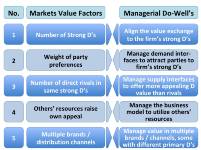Firm Success
Firm success in winning parties on the markets where it is active - customer market, labor market, business partner market and capital market - is derived from its score on five Markets Value Factors: the external success factors on the markets.
The firm's ability to score well on each Markets Value Factor is derived from its score on an associated Managerial Do-Well: the internal success factors in operations.
The five external and internal success factors are summarised in the following table and described further below.
Five Markets Value Factors
- Number of primary and secondary D’s:The higher the number of primary and secondary dimensions or “D’s”, the greater the chances of appealing to a larger volume of parties;
- Weight of party preferences: Offering strong value in a D or D’s in which the party preferences are weightiest improves the chances of a larger volume of parties;
- Fewer direct rivals in the same strong D or D’s: The fewer the number of rivals appealing to parties with the same preferences, the greater the “market share” of the firm within this group of parties, and hence the larger the volume of parties;
- Others’ resources raise own appeal: The firm raises the appeal of its own offers via the effective use of others’ resources, e.g. from rivals – replicating their innovations in its own offers – and from suppliers – benefiting from their product quality; and
- Multiple brands / distribution channels: In the e.g. auto and cosmetic industries, offering different brands with different primary and secondary D’s enables the firm to address a wider range of party segments with different preferences. In the e.g. retail industry, operating different channels, principally online and offline, enables the firm to address a wider range of ways that a given party segment wants to shop as well as a wider range of party segments with different preferences.
Five Managerial Do-Well's
- Align inputs with value offers: To generate value in a given D, the firm manages the value exchange such that the value inputs are aligned to generate value in a given D;
- External demand interfaces: To encourage parties to place a high weight on the firm’s strong D’s, the firm manages demand interfaces to attract parties to the appeal of the D’s;
- Internal supply interfaces: To face fewer direct rivals in the same strong D or D’s, the firm manages supply interfaces so as to generate a D value which is more appealing than that of rivals, which ultimately drives them out of the market and prevents entry;
- Business model: To utilize others’ resources in the own relations to parties, the firm operates with a business model which can take advantage of others’ resources in its own relations with parties; and
- Steering logic: To manage multiple brands / channels, the firm practices a steering logic for its activities which enables it to manage value in different brands / channels.
